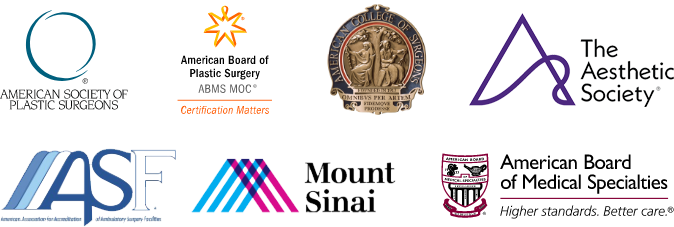As a NYC board-certified plastic surgeon, I have dedicated my practice to helping patients achieve natural and transformative facial rejuvenation. The deep plane facelift is one of the most advanced techniques I offer, providing long-lasting results by addressing deeper facial structures. This innovative procedure has become a popular choice among New Yorkers of nearly all ages, from their 30s to their 70s, who are looking for a refreshed and youthful appearance.
What Is a Deep Plane Facelift?
The deep plane facelift is not just about tightening the skin. It repositions the deeper layers of facial tissue—muscles, ligaments, and fat—to restore natural contours and comprehensively address signs of aging. Lifting these deeper structures makes the results more natural-looking and last longer than traditional facelifts.
Key aspects of this procedure include:
- Comprehensive Rejuvenation: It addresses sagging skin, deep nasolabial folds, and jowls in a single procedure.
- Enhanced Longevity: By targeting the foundational layers, the results can last over a decade.
- Minimal Scarring: Incisions are strategically placed in natural creases, ensuring they are discreet.
Why I Recommend the Deep Plane Facelift
Many of my patients choose this procedure because it offers unparalleled benefits:
- Natural Results: Unlike older techniques that may create a “pulled” look, the deep plane facelift focuses on lifting and repositioning the deeper layers, maintaining the natural harmony of the face.
- Long-Lasting Effects: The repositioning of the deeper tissues means the results age gracefully with you.
- Quicker Recovery: My advanced surgical methods reduce swelling and bruising, allowing most patients to resume light activities within weeks.
I often tell my patients, “The key to a successful facelift is not just improving how you look today but ensuring you continue to look great in the years to come.”
Who Is a Good Candidate for This Procedure?
In my experience, the ideal candidates for a deep plane facelift are those who:
- Are typically between the ages of 40 and 70, although younger individuals seeking preventative care can also benefit.
- Have visible signs of aging, such as sagging cheeks, jowls, or deep folds around the mouth.
- Are in good overall health, as this contributes to a smoother recovery and better results.
During a consultation, I conduct a detailed evaluation of your facial structure, skin quality, and aesthetic goals. This ensures the procedure is customized to meet your specific needs. I also talk with you about your concerns, so you can be more confident in your decision. I discuss some common facelift concerns in the video below.
The Procedure: A Surgeon’s Perspective
Performing a deep plane facelift is a meticulous process that requires a deep understanding of facial anatomy. Here is an overview of what you can expect:
- Incisions: These are carefully placed around the ears and hairline to minimize visibility.
- Tissue Repositioning: I lift and secure the deeper layers of the face to restore youthful contours.
- Skin Redraping: Excess skin is removed and redraped without tension, avoiding an over-tightened look.
Each step is tailored to your unique facial structure, and my goal is always to achieve results that enhance your natural beauty.
Recovery and Aftercare
A smooth recovery is just as important as the surgery itself. Here is what I typically advise my patients:
- First Week: Focus on rest and gentle care. Swelling and bruising are normal and will gradually subside.
- Weeks 2-4: You’ll notice significant improvements in facial contours. Many patients feel confident enough to resume social activities.
- Months 2-3: This is when your final results become fully visible.
To support your recovery, I recommend:
- Keeping your head elevated to reduce swelling.
- Avoiding strenuous activities for at least 6 weeks.
- Attending follow-up appointments so I can monitor your progress and address any concerns.
You can learn more about facelift recovery from The Aesthetic Society.
Pre- and Post-Surgery Guidelines
Before Surgery
- Arrange for someone to accompany you home and assist you during the first 48 hours.
- Avoid smoking and alcohol for at least 4 weeks prior to your surgery.
- Follow my detailed instructions regarding medications and supplements to avoid.
After Surgery
- Use cold compresses to manage swelling.
- Protect your skin from sun exposure by wearing sunscreen.
- Avoid wearing makeup until I confirm it’s safe to do so.
Understanding Local Trends
In New York City, I’ve observed a growing preference for procedures that provide subtle, natural enhancements. Patients here value results that allow them to look refreshed without appearing overdone. As a plastic surgeon, I tailor each procedure to match my patients’ diverse needs and goals, ensuring the best outcomes.
Advice for Different Age Groups
- In Your 30s to Early 40s: A deep plane facelift can be a preventative measure, maintaining youthful contours and addressing early signs of aging.
- In Your 40s and 50s: This is the ideal time for most patients to undergo the procedure, as it can significantly reverse visible signs of aging.
- In Your 60s and Beyond: Combining the deep plane facelift with complementary procedures like a neck lift or an upper eyelid lift can achieve comprehensive rejuvenation for older patients.
Next Steps
If you’re considering a deep plane facelift, I encourage you to schedule a consultation with me using our online form or calling my office at (212) 249-4020. Together, we’ll discuss your goals, evaluate your facial structure, and create a plan tailored to your needs. My commitment is to ensure you achieve a refreshed, natural look that enhances your confidence and complements your unique look.
Deep Plane Facelift FAQ
What makes the deep plane facelift different from traditional facelift techniques?
This procedure targets deeper facial layers for more natural and longer-lasting results, unlike traditional facelifts that focus on tightening the skin.
How long do the results of a deep plane facelift typically last?
Most patients enjoy results that last 10 to 15 years, depending on their lifestyle and skin quality.
What is the expected recovery timeline for this procedure?
Patients can typically resume light activities within 2 weeks, with full results visible in about 3 months.
Are there any risks involved?
While the risks are minimal, potential complications include swelling, bruising, or temporary nerve sensitivity. I take every precaution to ensure a safe and smooth recovery.
Does this procedure address sagging in the mid-face and jawline?
Yes, by repositioning the deeper layers, this procedure effectively restores mid-face volume and tightens the jawline.
Is a deep plane facelift suitable for younger patients?
Absolutely. In fact it’s a common facelift myth that facelift surgery is only for older adults. Younger individuals can benefit from subtle enhancements that delay the aging process.
How important is skin elasticity for this procedure?
Good skin elasticity enhances the results by supporting the repositioned structures, but even patients with reduced elasticity can achieve excellent outcomes with careful planning.
Medical References
- Modified Deep-Plane Face Lift and Lower Midface Lifting – Plastic and Reconstructive Surgery https://journals.lww.com/plasreconsurg/abstract/2024/06000/modified_deep_plane_face_lift_and_lower_midface.14.aspx
- Deep Plane Facelift – StatPearls – NCBI Bookshelf https://www.ncbi.nlm.nih.gov/books/NBK545277/
- Deep Plane Facelifts Under Tumescent Anesthesia: Review of Last 100 Cases – PMC https://pmc.ncbi.nlm.nih.gov/articles/PMC10566779/
- Vectorial Analysis of Deep Plane Face and Neck Lift – Aesthetic Surgery Journal https://academic.oup.com/asj/article-abstract/44/10/1015/7657725?redirectedFrom=fulltext
- There Is No Facelift for All Seasons – Aesthetic Surgery Journal https://academic.oup.com/asj/article/44/10/1127/7716597?login=false








Leave a Reply